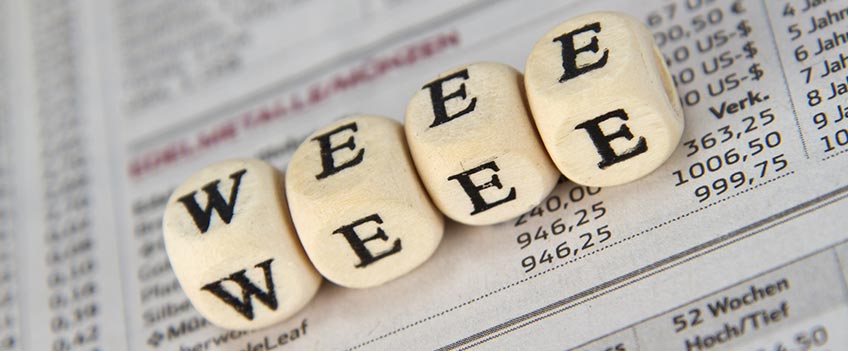
FREE AND ENVIRONMENTALLY FRIENDLY DISPOSAL OF DEWERTOKIN ELECTRICAL COMPONENTS
Products from DewertOkin GmbH from the segments of Office, Bedding and Seating are categorised and registered in accordance with the European WEEE Directive. This allows you to hand in DewertOkin electrical components at municipal collection points in Germany free of charge. Against the background of increasing electrical and electronic waste, we are simultaneously making an active contribution towards protecting the environment. Our official registration number (WEEE-reg. no.) is: DE 81994808
WHAT IS THE WEEE DIRECTIVE AND THE ELEKTROG?
The EU directive "Waste of Electrical and Electronic Equipment" (WEEE) aims to avoid waste from electrical and electronic equipment or to reduce it through recycling or reuse.
The Electrical and Electronic Equipment Act (ElektroG) implements this directive in national law. As a result, electrical and electronic equipment is recycled ecologically. This extends product responsibility for the entire life cycle of the devices to the distributor. With the amendment of the ElektroG on August 15, 2018, the scope of the law will be expanded to include electrical components in furniture, which DewertOkin GmbH is placing on the market.
The Battery Act (BattG) is aimed at manufacturers, distributors, end users and public waste disposal companies. The aim of this law is to reduce the entry of pollutants by waste from batteries. Our official registration number (BattG-reg. no.) is: DE 78550642
JOINT CONTRIBUTION TO THE ENVIRONMENT
The development of new technical devices is advancing rapidly. This applies not only to smartphones, notebooks or televisions, but also to electrical and electronic components of various types. The amount of electronic waste is therefore growing at the same rate. This has a long-term impact on the environment and the climate.
Electrical appliances contain not only valuable raw materials such as aluminum, silver, gold or copper, but also often materials that are hazardous to health and the environment. The devices must therefore be collected and recycled separately. The WEEE guideline ensures this separation and makes the process much easier by simply handing over old devices to collection and return points. This protects health and the environment..
WHICH TYPES OF DEVICES ARE AFFECTED BY THE NEW ELEKTROG?
In the collection and return points, electrical and electronic devices are sorted into six categories so that the requirements of the different devices can be better addressed when preparing for reuse.
• Category 1: heat exchanger
• Category 2: Screens, monitors and devices that contain screens with a surface area of more than 100 cm²
• Category 3: lamps
• Category 4: devices where at least one of the external dimensions is more than 50 cm (large devices)
• Category 5: Devices where none of the external dimensions is more than 50 cm (small devices)
• Category 6: Small information and telecommunications equipment with none of the external dimensions exceeding 50 cm
At the end of the recycling process, the recovered raw materials such as metals or plastics can be used, for example, to manufacture new products or for energy recovery.
SUMMARY OF PRACTICAL ADVANTAGES OF THE WEEE REGISTRATION
- Simple and free drop off at collection and recycling points
- No time-consuming "recycling facility search”
- Reliable utilisation of raw materials
- Increase in the recycling quota of electronic scrap
- Active contribution towards climate protection
SCOPE:
All products put on the market by DewertOkin GmbH under the name OKIN.










